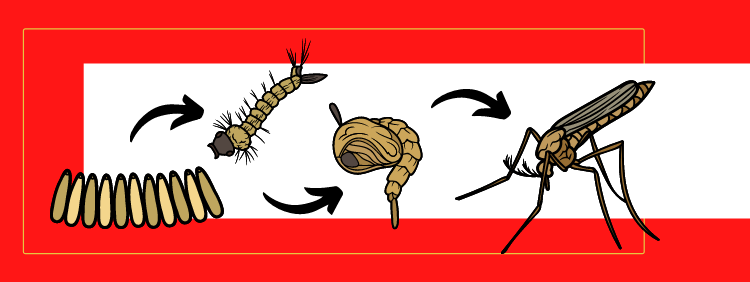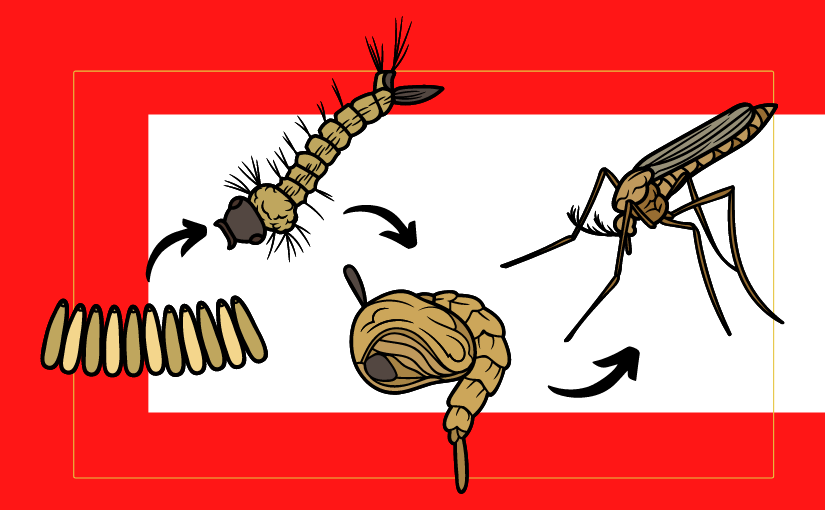
Calls for professional mosquito control are common among owners of homes and commercial buildings, and it is easy to understand why. Mosquitoes are among the most aggravating insects in existence. Their itchy bites cause misery for several days and can also expose you to disease. Mosquitoes only live for a month or two, but they don’t waste any time mating and laying eggs. Therefore, the new generation is coming of age just as the previous generation is dying off.
Knowing more about a certain pest can help you cope with it more effectively. Here is some valuable information about the mosquito’s life cycle.
1. Egg
A female mosquito’s main purpose in life is to breed the next generation. The reason that female mosquitoes bite is that the developing eggs need protein, and the only way the mosquito can get it is from blood. An individual mosquito can only lay eggs after having a blood meal.
Mosquitoes typically lay their eggs in standing water: the more stagnant, the better. A mosquito may also lay eggs on the moist ground prone to flooding. The water can be deep, but it doesn’t have to be. Mosquito eggs can thrive in water an inch deep.
Some mosquitoes stack their eggs on top of one another. The eggs form a “raft” by sticking together and floating on the surface. Other species scatter their eggs throughout the water by laying them one at a time.
2. Larvae
Mosquito eggs generally hatch within a matter of days, though with some species, it can take several months. Due to their swimming motions, mosquito larvae are called wrigglers or wigglers. With a length of approximately one-quarter of an inch, the larvae are small. They look like worms with segmented bodies covered with hair. They eat one-celled organisms such as fungi and algae, and hairs around their mouthparts help them to catch food.
Mosquito larvae spend most of their time near the surface of the water. They have a small tube from their abdomens called a siphon that allows them to breathe when they extend it above the surface.
Like adult mosquitoes, the larvae have a hard outer shell called an exoskeleton. When the larvae outgrow their shells, they moult. Mosquito larvae will moult four times before moving on to the next phase of their development. The time periods in between moults are called instars. Altogether, the larval stage can last up to two weeks.
Mosquito larvae cannot survive without water. If there is standing water on your property that contains mosquito larvae, draining the water will be effective at killing them.
3. Pupa
Mosquitoes undergo a complete metamorphosis, meaning that they go through a pupal stage between their larval and adult stages. A mosquito larva becomes a pupa when it goes through its fourth moult. A mosquito pupa is covered with a tough casing that protects the developing mosquito. The pupae typically float on the surface of the water, gaining oxygen from two breathing tubes called trumpets. Mosquito pupae are called tumblers because they may sink to the bottom of the vessel if threatened and move around in response to changes in light. The pupal stage lasts up to four days, during which the mosquito does not eat.
4. Adult
When the pupal stage is over, a full-grown mosquito emerges from its casing. Male mosquitoes emerge first, and a mating swarm takes place when the females emerge later. Once a male mosquito has mated, it has outlived its purpose and only lives for a few weeks, during which time it feeds on flower nectar.
Call Truly Nolen for Mosquito Control in Kitchener
While removing standing water can get rid of mosquito larvae, it doesn’t do anything for the adult mosquitoes that are still on your property. Truly Nolen offers pest control in Kitchener, including mosquito removal. Find out more about our services.
